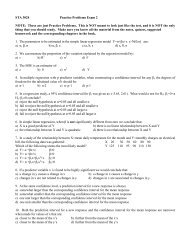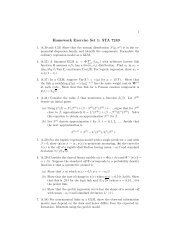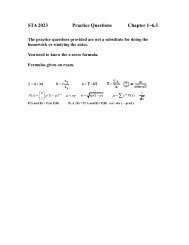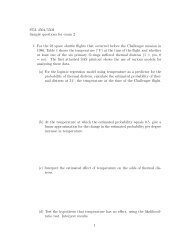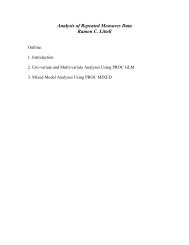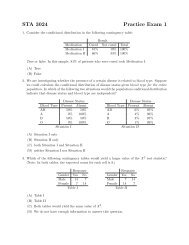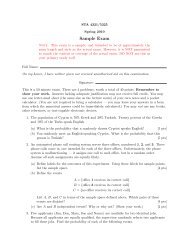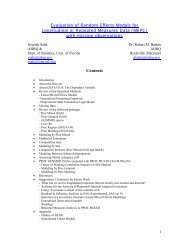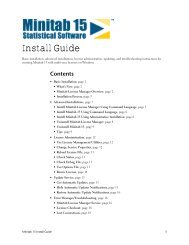STA 3024 Exam 1 Sample Questions
STA 3024 Exam 1 Sample Questions
STA 3024 Exam 1 Sample Questions
- No tags were found...
You also want an ePaper? Increase the reach of your titles
YUMPU automatically turns print PDFs into web optimized ePapers that Google loves.
11. The chi-squared test can provide information about(A) confidence intervals for the sample relative risk.(B) confidence intervals for the sample difference between conditional proportions.(C) the strength of the evidence of an association between two variables.(D) evidence of the strength of an association between two variables.12. In a chi-squared test with df = 6, a test statistic value of X 2 = 17.72 corresponds to a p-value(A) smaller than 0.001.(B) between 0.001 and 0.005.(C) between 0.005 and 0.010.(D) between 0.010 and 0.025.(E) between 0.025 and 0.050.13. For the contingency table shown below, calculate the difference between conditional proportionsof adults and children who answered “Agree.”(A) 0.060(B) 0.118(C) 0.159(D) 0.172(E) 0.301AnswerGroup Agree DisagreeAdults 106 150Children 57 10414. In a chi-squared test, which of the following would we usually have if the value of the test statisticX 2 is large?(A) a small p-value(B) variables that are independent(C) both (A) and (B)(D) neither (A) nor (B)15. Recall that in a contingency table, each cell’s standardized residual consists of its residual dividedby that residual’s standard error. Which of the following gives us enough information to calculatethe standard error of a cell’s residual?(A) the value of the chi-squared test statistic and the corresponding p-value(B) that cell’s observed and expected counts(C) the sample relative risk and the sample odds ratio(D) the overall total sample size and the row and column totals for that cell(E) none of the above



